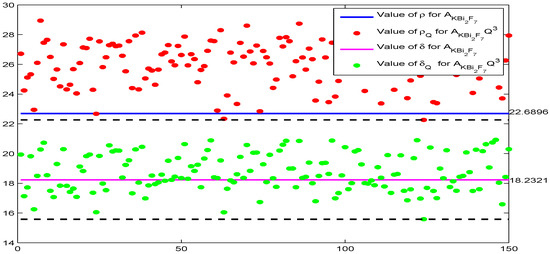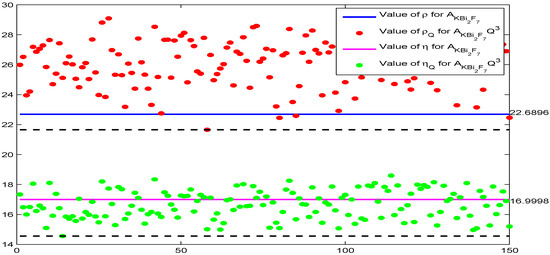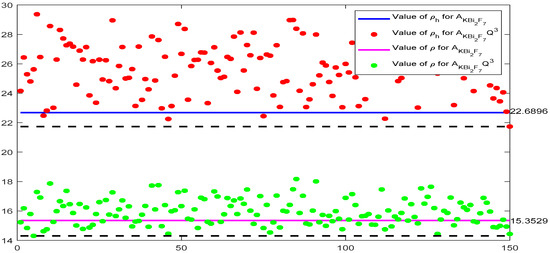Abstract
The C-eigenpair of piezoelectric tensors finds applications in the area of the piezoelectric effect and converse piezoelectric effect. In this paper, we provide some characterizations of C-eigenvectors by exploring the structure of piezoelectric tensors, and establish sharp C-eigenvalue inclusion intervals via Cauchy–Schwartz inequality. Further, we propose the lower and upper bounds of the largest C-eigenvalue and evaluate the efficiency of the best rank-one approximation of piezoelectric tensors. Numerical examples are proposed to verify the efficiency of the obtained results.
Keywords:
piezoelectric tensors; C-eigenvalue inclusion intervals; efficiency of the best rank-one approximation MSC:
15A18; 15A69
1. Introduction
Third-order tensors play an important role in physics and engineering, such as in solid crystal study [1,2,3,4] and liquid crystal study [1,5,6]. We know that piezoelectric tensors are the most well-known tensor among third-order tensors and come from applications in the piezoelectric effect and converse piezoelectric effect in solid crystals from [1,2,7].
Definition 1.
A third-order n dimensional real tensor is called a piezoelectric tensor, if the later two indices of are symmetric, i.e., for all , where
In order to explore the properties of the piezoelectric effect, Chen et al. [8] introduced the following C-eigenpair.
Definition 2.
For piezoelectric tensor , if there exists a scalar and vectors such that
where and with the i-th and the k-th entries
then λ is called a C-eigenvalue of x and y are called associated left and right C-eigenvectors, respectively. For simplicity, is called a C-eigenpair of
To investigate the existence and properties of C-eigenpairs of a piezoelectric-type tensor, we recall the following theorem established in [8].
Lemma 1.
[Theorem 2.3 of [8]] Let be a piezoelectric-type tensor. Then,
- (i)
- There exist C-eigenvalues of and associated left and right C-eigenvectors.
- (ii)
- Suppose that and y are a C-eigenvalue and its associated left and right C-eigenvectors of , respectively. ThenFurther, , and are also C-eigenpairs of tensor .
- (iii)
- Denote the largest C-eigenvalue of and its associated left and right C-eigenvectors as respectively. Then
Further, forms the best rank-one piezoelectric-type approximation of
As we know, the largest C-eigenvalue of a piezoelectric tensor has concrete physical meaning which determines the highest piezoelectric coupling constant [1]. In view of the significance of the largest C-eigenvalue, effective algorithms have been implemented [9,10,11]. As pointed out by Chen et al. [8], the number of C-eigenvalues is equal to when a piezoelectric tensor has finitely many equivalence classes of C-eigenvalues; it is very costly to compute the largest C-eigenvalue or all C-eigenvalues for a high-dimensional piezoelectric tensor. Thus, some researchers turned to giving an interval to locate all C-eigenvalues of piezoelectric tensors. Li et al. [12] first gave C-eigenvalue inclusion intervals to locate the C-eigenvalues of piezoelectric tensors via the S-partition method. Improved results can be found in [13,14,15,16]. As a special type of third-order tensor, piezoelectric tensors have unique properties on C-eigenvectors. For instance, for the right C-eigenvector y, the fact that holds. Therefore, if we perform an in-depth characterization of C-eigenvectors and the structure of a piezoelectric tensor, we shall establish sharp C-eigenvalue inclusion intervals. This constitutes the first motivation of the paper.
It is well known that the best rank-one approximation of a tensor has numerous applications in higher-order statistical data analysis [17,18,19,20]. For piezoelectric tensor its best rank-one approximation is to find a scalar and vectors which minimize the following optimization problem:
where and “∘” means the outer product and is a rank-one tensor [6,8]. Further, Chen et al. [8] showed that the largest C-eigenvalue and its C-eigenvectors form the best rank-one piezoelectric-type approximation of i.e.,
Thus, we obtain the quotient of the residual of a symmetric best rank-one approximation of piezoelectric tensor as follows:
which can be used to evaluate the efficiency of the best rank-one approximation. When we extract tensor information with the best rank-one approximation, a natural problem is how to quickly evaluate the efficiency of information extraction. Obviously, the smaller is, the greater the efficiency of the best rank-one approximation. Therefore, we want to estimate the upper and lower bounds of the largest C-eigenvalue to evaluate the efficiency of the best rank-one approximation of piezoelectric tensors, which represents the second motivation of the paper.
The remainder of the paper is organized as follows. In Section 2, we first recall some fundamental existing results. By virtue of components of the left and right C-eigenvector, we establish new C-eigenvalue inclusion intervals of piezoelectric tensors, and show that these C-eigenvalue intervals are sharper than some existing C-eigenvalue intervals. In Section 3, we use bound estimations of the largest C-eigenvalue to evaluate the efficiency of the best rank-one approximation of piezoelectric tensors. The validity of the obtained results is tested by some examples.
2. C-eigenvalue Inclusion Intervals for Piezoelectric Tensors
In this section, we shall establish some sharp C-eigenvalue inclusion intervals based on the exploration of its eigenvectors, and show that these C-eigenvalue inclusion intervals improve some existing results [12,13,14,16]. To proceed, we recall the C-eigenvalue inclusion intervals established by [12].
Lemma 2.
For piezoelectric tensor and its C-eigenvalue λ, it holds that
where and
From Theorem 2.3 of [8], we deduce that is a C-eigenvalue if is a C-eigenvalue. Hence, the C-eigenvalue inclusion interval is symmetric about the origin. Before proceeding further, we need to establish the following lemma on the C-eigenvector.
Lemma 3.
For unit vector it holds that
Proof.
For all , it follows from that
which implies □
Theorem 1.
Let λ be a C-eigenvalue of piezoelectric tensor . Then,
where and
Proof.
Let be a C-eigenpair of the piezoelectric tensor . Set and . Since and then and . By the p-th equation of in (1), we have
By the definitions of and Lemma 3, we obtain
which shows
On the other hand, the q-th equation of in (1) yields
Since and , we have
which implies
Multiplying (4) with (5) yields
Further,
□
Now, we give a theoretical comparison between Theorem 1 and Theorem 1 of [12].
Remark 1.
Noting that
we deduce that
Hence,
Thus, the interval in Theorem 1 captures all C-eigenvalues of piezoelectric tensors more precisely than the interval given in [12].
It is well known that C-eigenvalues are invariant under orthogonal transformations, i.e., for C-eigenpair of piezoelectric tensor and orthogonal matrix Q, is also a piezoelectric tensor [8,12], and is also a C-eigenvalue of tensor , where
Hence, Li et al. [12] derived the following new C-eigenvalue interval for a piezoelectric tensor:
where and denotes the orthogonal matrix sets. However, the interval given in Theorem 1 may not be invariant under orthogonal transformation, as shown below. Consider the piezoelectric tensor in [8,21] with its nonzero entries
For orthogonal matrix
we have
Further, taking 150 orthogonal matrices Q generated by the MATLAB code
we could obtain various values of and for and ; see Figure 1.

Figure 1.
Comparisons among and in [12] and and for and .
Obviously, there are some orthogonal matrices Q such that in Theorem 1 becomes smaller. From the arbitrariness of orthogonal matrix Q, for C-eigenvalue of piezoelectric tensor it holds that
Corollary 1.
Let be the largest C-eigenvalue of piezoelectric tensor . Then,
where
By and Cauchy–Schwartz inequality, we are in the position to establish the following theorems.
Theorem 2.
Let λ be a C-eigenvalue of piezoelectric tensor . Then
where and
Proof.
Let be a C-eigenpair of the piezoelectric tensor . Setting and , we obtain and By the p-th equation of in (1), we have
and
where the third inequality uses Cauchy–Schwartz inequality and the second equality follows from .
On the other hand, recalling the q-th equation of in (1), one has
Since and , we have
where the third inequality uses the Cauchy–Schwartz inequality and the equality follows from Multiplying (6) with (7) yields
and
By the definitions of and we obtain
□
Now, we make another theoretical comparison of the upper bounds given in Theorem 2 and Theorem 1 in [12].
Remark 2.
It is easy to verify that
Hence,
Thus, the interval captures all C-eigenvalues of piezoelectric tensors more precisely than the interval given in [12].
Similarly, the interval given in Theorem 2 may not be invariant under orthogonal transformation. Following the generation process of the orthogonal matrix of Corollary 2, we obtain various values of and in [12] and and for and ; see Figure 2.

Figure 2.
Comparisons among and in [12] and and for and .
Corollary 2.
Let be the largest C-eigenvalue of piezoelectric tensor . Then
where
In the following, we propose a sharp C-eigenvalue inclusion interval based on the symmetry of piezoelectric tensors.
Theorem 3.
Let λ be a C-eigenvalue of piezoelectric tensor . Then
where
Proof.
It follows from (ii) of Lemma 1 that
For C-eigenvalue , using Cauchy inequality, we obtain
where Further,
where is a symmetric matrix. Then, it follows from Girshgorin circles for the matrices that
which implies
□
It should be noted that interval given in Theorem 3 may not be invariant under orthogonal transformation. In fact, following the generation process of the orthogonal matrix of Corollary 1, we can obtain various values of and in [12] and and for and ; see Figure 3.

Figure 3.
Comparisons among and in [12] and and for and .
Corollary 3.
Let be the largest C-eigenvalue of piezoelectric tensor . Then
where
Now, we utilize numerical examples given in [2,3,8,21] to show the superiority of the obtained results.
Example. 1.
(I) Take piezoelectric tensor with its nonzero entries
(II) Take piezoelectric tensor with its nonzero entries
(III) Take piezoelectric tensor with its nonzero entries
(IV) Take piezoelectric tensor with its nonzero entries
(V) Take piezoelectric tensor with its nonzero entries
(VI) Take piezoelectric tensor with its nonzero entries
(VII) Take piezoelectric tensor in the above; also see [8,21].
(VIII) Take piezoelectric tensor with its nonzero entries
We locate all C-eigenvalues of the above eight piezoelectric tensors by different methods. Since each interval mentioned above is symmetric about the origin, we only list the right boundary of each interval. Numerical results are shown in Table 1.

Table 1.
Comparisons among Li’s method [12], Che’s method [13], Xiong’s method [16], He’s method [14], Liu’s method [15] and our method.
In Table 1, represents the largest C-eigenvalue of a piezoelectric tensor; and are the right boundaries of the intervals and obtained by Theorems 1 and 2 of [12]; is the right boundary of the interval obtained by Theorem 2.1 of [15]; and are the right boundaries of the intervals and obtained by Theorems 2.1, 2.2 and 2.4 of [13]; is the right boundary of the interval obtained by Theorem 2.1 of [16]; is the right boundary of the interval obtained by Theorem 5 of [14]; and are the right boundaries of the intervals and obtained by Theorems 1–3. Numerical results reveal that our results are sharper than those of [12,13,14,15,16] Table 1.
3. Efficiency Evaluation of the Best Rank-One Approximation of Piezoelectric Tensors
In this section, we will propose sharp bound estimations of the largest C-eigenvalue, and evaluate the efficiency of the best rank-one approximation of piezoelectric tensors based on the quotient of the residual in [22,23,24]. First, we give a lower bound of the largest C-eigenvalue for the piezoelectric tensor .
Theorem 4.
Let be the largest C-eigenvalue of piezoelectric tensor . Then,
Proof.
It follows from (iii) of Lemma 1 that
Next, we break down the proof into two cases to show
In order to prove , we set
or
Following similar arguments to the proof of Cases I and II, we obtain
It follows from (11) and (12) that
□
In what follows, we propose lower bounds of the largest C-eigenvalue of the eight piezoelectric tensors in Example 1. Numerical results are shown in Table 2, where represents the lower bound of the largest C-eigenvalue for a piezoelectric tensor.

Table 2.
Lower bound estimations of the largest C-eigenvalue in Theorem 4.
In the following, we propose bound estimations for the quotient of the residual , which evaluate the efficiency of the best rank-one approximation for piezoelectric tensors.
Theorem 5.
For piezoelectric tensor , it holds that
where and κ are defined in Theorems 1–4.
Proof.
Since is a piezoelectric tensor, from Lemma 2, we deduce that is a best rank-one approximation of , i.e.,
where is the largest C-eigenvalue. From Theorems 1–4, we obtain that the quotient of the residual of piezoelectric tensor is
□
In the following, we will calculate the quotient of the residual of the eight piezoelectric tensors in Example 1. For the first piezoelectric tensor we know from Table 1 and Table 2, where represents the largest C-eigenvalue. Thus, we compute
which evaluates the efficiency of the best rank-one approximation for piezoelectric tensor The quotients of the residual of the other seven piezoelectric tensors in Example 1 are listed in Table 3.

Table 3.
Bound estimations of the quotient for the residual .
4. Conclusions
In this paper, we proposed sharp C-eigenvalue inclusion intervals based on the structure of piezoelectric tensors and obtained good numerical results. More importantly, we established not only the upper bound but also the lower bound of the largest C-eigenvalues to evaluate the efficiency of the best rank-one approximation of piezoelectric tensors. It is unfortunate that we attempted to estimate the largest C eigenvalue but did not obtain the real largest C-eigenvalue. Further studies can be considered to develop efficient algorithms to calculate quickly the largest C-eigenvalue of a high-dimensional piezoelectric tensor by our C-eigenvalue inclusion intervals.
Author Contributions
Writing—original draft and editing, G.W.; software, X.Y.; supervision, writing—review and funding acquisition, W.S.; writing—review, Q.H. All authors have read and agreed to the published version of the manuscript.
Funding
This research is supported by the Natural Science Foundation of Shandong Province (ZR2020MA025, ZR2019PA016, ZR2021MA090), the National Natural Science Foundation of China (11901343) and the Postdoctoral Science Foundation of China (2020M682143).
Data Availability Statement
Not applicable.
Conflicts of Interest
The authors declare no conflict of interest.
References
- Chen, Y.; Qi, L.; Virga, E. Octupolar tensors for liquid crystals. J. Phys. A 2018, 51, 025206. [Google Scholar] [CrossRef] [Green Version]
- Curie, J.; Curie, P. D’eveloppement, par pression, de l’electricit’e polaire dans les cristaux h’emiedresa faces inclin’ees. Comptes Rendus 1880, 91, 294–295. (In French) [Google Scholar]
- Haussuhl, S. Physical Properties of Crystals: An Introduction; Wiley-VCH Verlag: Weinheim, Germany, 2007. [Google Scholar]
- Kholkin, A.; Pertsev, N.; Goltsev, A. Piezolelectricity and crystal symmetry. In Piezoelectric and Acoustic Materials; Safari, A., Akdogan, E.K., Eds.; Springer: Berlin/Heidelberg, Germany, 2008. [Google Scholar]
- Gaeta, G.; Virga, E. Octupolar order in three dimensions. Eur. Phys. J. E 2016, 39, 113. [Google Scholar] [CrossRef]
- Qi, L. Transposes, L-eigenvalues and invariants of third order tensors. arXiv 2017, arXiv:1704.01327v5. [Google Scholar]
- Zou, W.; Tang, C.; Pan, E. Symmetric types of the piezotensor and their identification. Proc. R. Soc. A 2013, 469, 20120755. [Google Scholar] [CrossRef]
- Chen, Y.; Jakli, A.; Qi, L. The C-eigenvalue of third order tensors and its application in crystals. J. Ind. Manag. Optim. 2021. [Google Scholar] [CrossRef]
- Liang, C.; Yang, Y. Shifted eigenvalue decomposition method for computing C-eigenvalues of a piezoelectric-type tensor. Comput. Appl. Math. 2021, 40, 1–22. [Google Scholar] [CrossRef]
- Liu, X.; Mo, C. Calculating C-eigenpairs of piezoelectric-type tensors via a Z-eigenpair method. Appl. Math. Comput. 2022, 426, 127124. [Google Scholar] [CrossRef]
- Zhao, J.; Luo, J. Properties and calculation for C-eigenvalues of a piezoelectric-type tensor. J. Ind. Manag. Optim. 2021. [Google Scholar] [CrossRef]
- Li, C.; Li, Y. C-eigenvalues intervals for piezoelectric-type tensors. Appl. Math. Comput. 2019, 358, 244–250. [Google Scholar] [CrossRef] [Green Version]
- Che, H.; Chen, H.; Wang, Y. C-eigenvalue inclusion theorems for piezoelectric-type tensors. Appl. Math. Lett. 2019, 89, 41–49. [Google Scholar] [CrossRef]
- He, J.; Liu, Y.; Xu, G. An S-type inclusion set for C-eigenvalues of a piezoelectric-type tensor. Appl. Math. Lett. 2021, 121, 107448. [Google Scholar] [CrossRef]
- Liu, X.; Yin, S.; Li, H. C-eigenvalue intervals for piezoelectric-type tensors via symmetric matrices. J. Ind. Manag. Optim. 2021, 17, 3349–3356. [Google Scholar] [CrossRef]
- Xiong, L.; Liu, J. A new C-eigenvalue localisation set for piezoelectric-type tensors. East Asian J. Appl. Math. 2020, 10, 123–134. [Google Scholar]
- Kofidis, E.; Regalia, R. On the best rank-1 approximation of higher-order supersymmetric tensors. SIAM J. Matrix Anal. Appl. 2002, 23, 863–884. [Google Scholar] [CrossRef] [Green Version]
- Lathauwer, L.; Moor, B.; Vandewalle, J. On the best rank-1 and rank-(R1, R2, …, RN) approximation of higher-order tensors. SIAM J. Matrix Anal. Appl. 2000, 21, 1324–1342. [Google Scholar] [CrossRef]
- Wang, G.; Zhou, G.; Caccetta, L. Z-eigenvalue inclusion theorems for tensors. Discrete Contin. Dyn. Syst. Ser. B 2017, 22, 187–198. [Google Scholar]
- Zhang, T.; Golub, G. Rank-1 approximation of higher-order tensors. SIAM J. Matrix Anal. Appl. 2001, 23, 534–550. [Google Scholar] [CrossRef]
- Jong, M.d.; Chen, W.; Geerlings, H.; Asta, M.; Persson, K. A database to enable discovery and design of piezoelectric materials. Sci. Data 2015, 2, 150053. [Google Scholar] [CrossRef] [Green Version]
- Denning, D.; Kilpatrick, J.I.; Fukada, E. Piezoelectric Tensor of Collagen Fibrils Determined at the Nanoscale. ACS Biomater. Sci. Eng. 2017, 3, 929–935. [Google Scholar] [CrossRef] [Green Version]
- Qi, L. The best rank-one approximation ratio of a tensor space. SIAM J. Matrix Anal. Appl. 2011, 32, 430–442. [Google Scholar] [CrossRef] [Green Version]
- Wang, K.; Cao, J.; Pei, H. Robust extreme learning machine in the presence of outliers by iterative reweighted algorithm. Appl. Math. Comput. 2020, 377, 125–186. [Google Scholar] [CrossRef]
Publisher’s Note: MDPI stays neutral with regard to jurisdictional claims in published maps and institutional affiliations. |
© 2022 by the authors. Licensee MDPI, Basel, Switzerland. This article is an open access article distributed under the terms and conditions of the Creative Commons Attribution (CC BY) license (https://creativecommons.org/licenses/by/4.0/).